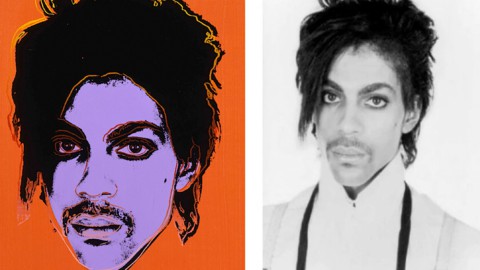Ungrateful times for contemporary artists. Between the canceling fury of certain influential liberal circles and obsessed with copyright, on the other side of the political spectrum, the unthinkable can really happen. And it actually happened to an artist like Andy Warhol who changed modern taste and the very way of conceiving the work of art.
The United States Court of Appeals for the Second Circuit in New York ruled that Andy Warhol, in 1984, infringed Lynn Goldsmith's copyright (photographer) appropriating one of his shots to create the screen printing series of the rock star Prince. To aggravate the fact, the Warhol Foundation granted the right to reproduce the silkscreen to the magazine "Vanity Fair" to commemorate the disappearance of the musician. It was this use that prompted Goldsmith to go to court as an injured party of copyright.
In the first judgment, the court agreed with the Wahrol Foundation. But Goldsmith won on appeal. In fact, according to the Court of Appeal Warhol's work was not sufficiently transformative of the source to enter the protection offered by fair use. Therefore Goldsmith's claims are legitimate. remember that the principle of fair use does not exist in European legislation.
Paraphrasing Picasso, Steve Jobs, who knew a lot about transformative stuff, said with self-satisfaction "Great artists don't copy, they steal". But when it was Bill Gates who stole, Jobs took him to court. But Bill was not an artist, but a mediocre copyist (according to Jobs). "The only problem with Microsoft - said Jobs - is that they simply have no taste" in copying or stealing.
Now even Warhol has been microsoftized by three New York judges.
The rationale of the sentence
We reproduce in the original language the crucial passage of the Court of Appeal ruling on Prince's screen printing:
Warhol did not create the Prince Series by taking his own photograph of Prince in a similar pose as in the Goldsmith Photograph. Nor did he attempt to copy merely the “idea” conveyed in the Goldsmith Photograph. Rather, he produced the Prince Series works by copying the Goldsmith Photograph itself — ie [ie], Goldsmith's particular expression of that idea.
This is not to say [this does not mean] that every use of an exact reproduction constitutes a work that is substantially similar to the original [thank goodness!]. But here, given the degree to which Goldsmith's work remains recognizable within [in] Warhol's, there can be no reasonable debate that the works are substantially similar.
Therefore:
Prince Series works are not protected by fair use. … Any re-user's work must reasonably be perceived as embodying an [inclusive] entirely distinct artistic purpose, one that conveys a new meaning or message.
A recolored photocopy
Evidently Warhol's reuse not only faithfully reproduces the source but does not present any element that conveys a different artistic purpose, new meaning or particular message. It is essentially a recolored photocopy.
Who cares, , promising there is the complete text of the judgment (60 pages) in the case “The Andy Warhol Foundation for the Visual Arts, Inc. vs. Lynn Goldsmith, Lynn Goldsmith, Ltd.”.
The art critic of the "New York Times", Blake Gopnik, intervened on this matter with an article to which the New York newspaper dedicated an entire page.
It is interesting to follow Gopnik's argument on the theme of artistic appropriation which, one can bet, will often come back to hammer the contemporary art world.
Here is the Italian version.
Artistic appropriation or creative use?
A few years ago, a group of art critics declared Marcel Duchamp's 1917 sculpture “Fountain” — a urinal bought in a shop and presented as such as the artist's work (later lost) — was the most influential work of art of the XNUMXth century.
Andy Warhol's 1964 Brillo Boxes—reproductions of tampon boxes also presented as art—could have easily taken second place. Philosopher Arthur Danto has built a distinguished career and an entire school of thought around the importance of those boxes that are fundamental to understanding modern aesthetics.
Last month, three judges in a federal appeals court in Manhattan declared themselves art experts, more than any other critic or philosopher. Whether they wanted to or not, their ruling had the effect of declaring that the inventions of Duchamp and Warhol — which are based on an "artistic appropriation" — were not worthy of receiving the legal protection that is given to creativity from the beginning of fair use under United States copyright law.
Fair use
The "fair use" should establish guidelines regarding the ability for an artist to take the creation of a peer, without permission and without payment. Fair use aims to prevent copyright law — which protects an artist's creation — from completely blocking "the ability of authors, artists and all of us to express ourselves and to express ourselves by referring to the works of others", as had sentenced the same court of appeal in Manhattan, in a decision in favor of the artist Jeff Koons who had "appropriated" a fashion photo for one of his paintings.
Many creative products need to "mention" other works. Imagine a critic who wants to quote a poem to show how bad it is, or a cartoonist who copies a Warhol acrylic to make fun of it.
The concept of transformation
Courts have ruled that this type of use is permitted if, among other things, the original work undergoes a transformation in the process of re-use. In other words, even if the comic closely resembles Warhol's painting (it may be inherently necessary), as long as its goals and functions are different enough from the original, the "transformation" inherent in the use would make it sheltered from copyright infringement.
The "transformative" characteristic, on the other hand, is not necessary when an artist manages to obtain permission to use an image or a creation from the owner of the right. But imagine a Duchamp, a Warhol, a Koons, with their outsized egos, phoning around asking for permission to use a urinal, a celebrity photo, or an art shot. Dispossessed authors should erect a monument to these great artists just by being reproduced.
In the Goldsmith case, the trial court found that in the process of going from Warhol's black-and-white photo to color screenprint, Prince's image had undergone a transformative action that made it fair use.
Collage, the standard of fair use
The Assiste court, however, overturned the judgment citing a Supreme Court decision stating that reuse of a work must be "entirely separate from its source material."
Fair enough. This is exactly what happened when Warhol used the Brillo boxes in his own way. Once presented as works of art in a gallery, these objects were given a new purpose and conveyed a different meaning and message than the same boxes stacked in a supermarket warehouse.
But the transformation of Prince's photo, according to the judges, was so minimal that the source could be recognized immediately. Something very different from collage — “a work of art that draws from numerous sources” — which the judges themselves have indicated as the canon of artistic transformation protected by fair use.
In fact, to make a truly original work of art, reuse often needs to remain very close to its source. Many great modern artists not only do not "draw on numerous sources" in copying from others, but they do not make any kind of aesthetic change to the single image from which they are drawing.
I know…
If Warhol had introduced aesthetically transformative elements for their own sake into the boxes, to make them look less like the Brillo originals — if he had collaged the labels of Palmolive soap and Brillo sanitary pads — they would not have created such a transformative art as reproducing them and stack them as they are. Uniformity, the act of preserving the essential elements of an existing image is precisely Warhol's ultimate modus operandi and what makes him one of the most important modern artists.
In his paintings Campbell's Soup did not significantly change the soup label, except for some enlargement; his screenprints of Marilyn did not add much to 20th Century Fox's black-and-white portrait of Marilyn Monroe, other than adding raw color to it rarely; ditto for his copies of the Mona Lisa.
The concept of transformation
The concept of “transformative” has been driving lawyers and judges crazy ever since the US Supreme Court first introduced it in 1993. Once you get to the point, though, it turns out that it is extremely difficult to figure out if the function, meaning and the message of one work resting on another can be artistically transformative. Are Mustaches and Mona Lisa Tweezers Transformative? Certain! Art itself is transformative.
In fact, art consists in finding new ways of expression, new models of representation and use. How can one imagine that a court can establish something normative in this regard even in a dynamic system such as that of the common law.
After analyzing all possible options, Christopher Sprigman, professor of intellectual property law at New York University, threw in the towel. Copyright law, he said, “is very well done but it's not very deep — and art is just the opposite. When the two collide, problems arise.”
Can the courts decide?
Under current legislation, Sprigman said, nearly all fair-use decisions, or at least complicated ones, inevitably involve the development of some kind of "aesthetic theory." The kind of "theory" that, for example, led the Court of Appeal to decide that collage is the canon of fair use in the field of figurative arts. And aesthetic theory is, to say the least, not the territory where judges are the world's leading experts.
But Sprigman says that, as things stand, there aren't many solutions other than that of an aesthetic judgment.
If the judges have no choice but to consider the aesthetic — because one work deserves the right to build upon another, to propel the creativity of our entire culture forward — then there is no choice but to consider what art had more relevance in the past. If, in the 60s, a judicial decision had prevented Warhol from being able to make his Marilyns — if a court had forced him to collage Marilyn's face with Kim Novak's — we would all be artistically poorer today.
Great artists copy
Warhol's artistic heirs must be able to use the appropriation that he pioneered to take art to new places, in the same way that the Impressionists got their start from Titian's pioneering brushwork.
There are many things judges can do with a sentence, but rewriting art history is not their job. Appropriation is one of the great artistic innovations of the modern era. The non-artist's job is to make sure the law recognizes it.
Great artists copy and they are not the only ones.
Source: Blake Gopnik, Warhol to Lame Copier? The Judges Who Said So Are Sadly Mistaken, The New York Times, April 5, 2021





